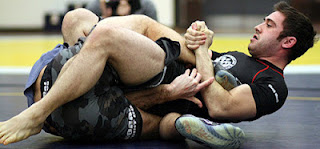Sambo coach at R Dojo and no gi grappling champion Reilly Bodycomb has just released his first book “Sambo Wrestling” and we here at the Ground Never Misses get a peak inside along with an exclusive interview with the man himself!
No stranger to teaching, Reilly has produced several excellent DVDs including “Dynamic Entries” and two excellent volumes on leg locks, as well as coaching and competing at the highest levels of Sambo competition (took bronze at the 2012 British Sambo Open -68kg). This text not only represents a seminal work for Bodycomb, but also for Sambo as a whole. Through the popularity of MMA and the incessant rise in participation in all grappling systems, Sambo has become more popular in the US in recent years then ever before. Still it is poorly understood and rarely seen outside of its own niche community. 
“Sambo Wrestling” is the first book, in English, to address the rule set and demonstrate some fundamental techniques found in sport Sambo. And to be brutally honest it is really the first quality book on Sambo I have seen! Previous volumes have been rather “gimmicky” if you will where the author seemed more interested in re-branding certain moves in an attempt to make his mark in the MMA community then actually teaching fundamentals of the art of Sambo. And while there are many a volume printed in Russian, to the best of my knowledge none of those have been publicly translated. My Russian is rusty so I cannot comment on the quality of the texts to begin with.
The color photography and larger size are what give “Sambo Wrestling” an excellent first impression. The photo’s are crisp and clear and catch the dynamics of a moving throw (QUITE difficult to do with sacrifice throws by the way!) in excellent detail. Both demonstrator and demo dummy are clothed in opposing colors (red / blue) to make clear distinctions for grappling positions that are often rather convoluted in a two dimensional context. This may seem trivial to some of you, but in my semi-professional opinion if the two people on screen or in print have the same colored uniforms, it is an automatic deal breaker in terms of ease of instruction.
After an excellent chapter on rules (always good to familiarize yourself with rule sets) the very first technique Bodycomb teaches is basic rolling and falling. Absolutely brilliant! My first lesson with any student covers basic break falls and rolling for one simple reason…. it is the most important “technique” in your self defense repertoire. As a martial arts instructor I can honestly state that the odds of you using any kick, submission, throw, or crazy superman punch is next to nill in real life. But I promise, dare I say guarantee, that sometime over the coming decades left in your life that you will; slip / trip / stumble / fall etc. Statistically falls are the number one killer of senior citizens. Now imagine if everyone had required grappling classes in elementary school and learned how to fall properly! To the best of my knowledge this is one of the only books from any grappling system that covers break fall’s and rolling. It is not that Sambo does it so differently, it is the simple fact that Reilly had the forethought to make proper falling the first technique you learn. Most teachers would gloss over such a minor, assumed technique.
Over 92 pages Reilly guides the reader through some of the throws and takedowns that he feels are a bit unique to Sambo, showing variations from several grips. A few pages are dedicated to ground work, but the majority of Sambo is played standing up and therefore takedowns and throws are the focus here including a couple of Reilly’s infamous dynamic entry throws!
I like that Reilly did not oversaturate the text with as many variations and techniques as he could find. “Sambo Wrestling” is meant to be a solid introduction to the sport of Sambo, and certainly could be used as a basic textbook for coaches and students alike looking to expand their understanding of grappling. For the most part (heel hooks and body scissor takedowns aside) everything shown here can be applied to a Judo or BJJ game seamlessly.
Written in clear concise language, accompanied by excellent photographs “Sambo Wrestling” is an essential text for any grapplers library. To top it off Reilly is a super nice cat who has a laid back approach to life that is obviously filled with his passion to be involved in every aspect of the sport of Sambo. You can contact Reilly directly to arrange seminars or lessons through R Dojo’s website. For those of you living in the New Orleans area, I highly suggest you take advantage of such a knowledgeable and open teacher in your neck of the bayou. I am not sure how long he will be living there, so soak up what you can!
Sliding in at a reasonable $25 you can order your copy from Amazon by clicking here.
(JB) How did you get involved in such a relatively rare martial art such as Sambo?
(RB) I was always fascinated with martial arts, ever since watching Ninja Turtles when I was a kid. When I moved to NYC for college I started training in a lot of different traditional martial arts looking for something I really liked. At some point I was at a party being held at the Karate Dojo I was training in at the time, and someone showed me some weird move. I don’t remember what the move was, but it was awesome. I asked him where he had learned it, and he said it was a Sambo move. I had no idea what Sambo was, and so I searched the Internet for Sambo schools when I got home and started training the next week. That was 7 years ago, I think.
Is your recent move to Louisiana an attempt to spread the art of Sambo to areas of the US that might not have access to such grappling styles?
 No, not at all. My wife is in Teach for America. It is a program that sends school teachers around the country to places that need them. She has been placed in New Orleans for the next 2 years, so here I am.
No, not at all. My wife is in Teach for America. It is a program that sends school teachers around the country to places that need them. She has been placed in New Orleans for the next 2 years, so here I am.
What was your intent with writing “Sambo Wrestling?”
Most people do not know what Sambo is. Those who do know are not really sure exactly what it entails. Many people have a vague notion that it has something to do with leg locks, but that is pretty much it. When someone desires to investigate further they usually hit a road block built of misinformation, or at least hard to come by information. My main goal was to write a book that both thoroughly explains the rules of competitive Sambo to an English speaking audience and then demonstrates some unique grappling techniques that stem from that rule set. I did not set out to teach the history of Sambo, but more explain what the sport looks like in modern times.
Will there be follow up volumes?
This book was incredibly hard to make. It was much more work than my previous DVDs. It has been in production for over a year! I may write another book someday, but right now I’m taking a break from writing.
In your book I noticed a heavy emphasis on take downs and throws, can we expect future volumes to cover more groundwork as well?
Competitive Sambo is mostly take downs, as is explained in the book. The majority of a match is done standing, and the majority of the points have to be scored from a take down. Submissions are an important element, but not usually the prevailing element. In future books I may show more details on ground fighting, sure, but to concentrate on that in this book would not be an accurate representation of Sport Sambo.
How important / what role does competition play in your eyes?
Competition has been extremely important to me. It helped me broaden my understanding of what was out there in a way that just watching videos online cannot. It has also helped me meet lots of people in the grappling community. I think it’s a great thing for anyone involved in grappling arts to do at least a few times, as it really will evolve your understanding of your sport. A few years ago I would compete every few months and I’m glad I did. Now I don’t compete that often, and I concentrate more on teaching. However, I still like to get out of the country once a year and compete in a big Sport Sambo event if I get a chance.
How does one attain rank in Sambo? Is competition required for rank advancement?
There is no universally recognized rank in Sambo the way there is in BJJ or Judo. However, there is a ranking system based on competition similar to how we rank college Wrestling in this country. For instance you can be ranked ‘Master of Sport’ and that means that you have beaten several other athletes of a certain competitive level. Sometimes they give out ‘Master of Sport’ for various contributions to the Sport as well. Every now and then (usually in the USA) you hearsomeone say that they have a ‘black belt in Sambo.’ This is not universally recognized by any governing body, and it is some sort of in-house rank given in their gym. FIAS, the international Sambo Federation does not recognize nor give out ‘belts’ of any color. The red and blue belts you see on Sambo athletes are just signifying the corner the athletes are assigned to on the mat, just like in boxing.
There has been lots of talk in sport BJJ about the rampant use of steroids and PED’s. Is this something that is a problem in sport Sambo? If so how is it addressed, if at all?
I have no idea if it’s a problem in Sambo. I have not heard anything about it, but there are few publications about Sambo written in English, so perhaps I’m just out of the loop.
On a similar note Nick Diaz has been suspended from MMA for marijuana use (legally prescribed by his doctor in California); in your opinion should marijuana be treated the same as PED’s?
I am not an expert, and so I do not think I have a relevant opinion on the matter.  You have competed in a number of different formats (MMA / Submission wrestling / Combat Sambo / Sport Sambo); what is your favorite format to compete in and why?
You have competed in a number of different formats (MMA / Submission wrestling / Combat Sambo / Sport Sambo); what is your favorite format to compete in and why?
When rolling in the gym I LOVE no-gi grappling. If I have a good training partner, no-gi is the most entertaining thing for me to do on the mat. I like the flow, the pace and the quick scrambles. However, when it comes to competing, my favorite is Sport Sambo. I really enjoy traveling with and meeting other people who train in Sambo, and I enjoy the format and vibe of Sambo tournaments.
Favorite grappler to watch?
Probably Megumi Fuji, I love her style. Or Rumina Sato, especially in those old Combat Wrestling matches. In Sambo it would have to be Igor Kurinnoy. He is was so freaking good at everything!
Favorite MMA fighter to watch?
I like watching Imanari and Kitaoka. Guys that hunt submissions are my favorite.
The Russian’s are renown for their preparation and development in regards to competition in all sports. Do you as a Sambist (?) follow any certain diet regime, or conditioning program that you would call “unique” to the grappling community?
No not really. I HATE cutting weight. I LOVE food.
One piece of advice for students?
It is really easy for a student to begin to form limiting opinions about themselves that stick for their entire grappling career. The one I hear the most of course is, “I’m not a leg lock guy,” or something like that. But there are other examples to be sure: “My legs are too short for triangles” is a common one, or “I don’t playing guard, because I wrestle.” These things will stick in people’s heads, almost as a matter of pride. People like to define things, and defining themselves is one of the easier things to do.
I would suggest that all students, from beginners to wise old masters, add the word ‘yet’ to these definitions. So the new line should be, “I’m not a leg lock guy… yet.” I have been guilty of it myself. But I think we will all get better faster if we avoid walling sections of the game off mentally.
One piece of advice for coaches?
I think it is very important to acknowledge that there is more than one way to skin a cat. People in the martial arts have a way of becoming extremely zealous about their ideas and techniques. It is easy to become this way when you have a room full of people who believe whatever you say. Try imparting to your students a sense of open mindedness and excitement for what you teach as opposed to a dogmatic “this way is the only way” approach. Because what that leads to down the road is very limited grapplers. Grapplers should know that there are many styles and approaches to doing things within the sport they are learning. Furthermore, they should know that there are other sports that do similar things. They should know that BJJ is not the only sport that has armbars. They should know that the armbar used in Judo or Sambo can often be the same armbar they are learning in BJJ. They should know that the armbar done by a short, stocky person may be different than the one used by a tall, lanky person, and that is ok.
Now, I do not mean to say that a coach should teach a billion different armbars. A coach should teach what they feel is a solid, good technique that the student can comprehend. But the coach should recognize that they are the conduit through which the student learns about the martial arts, so they have a responsibility to let them know that there are other ways of doing things.
Thanks Reilly!
Cheers
Jake
